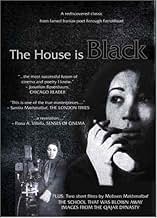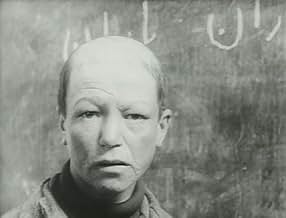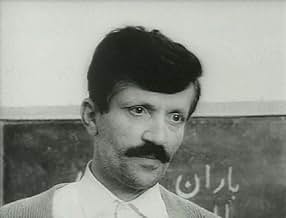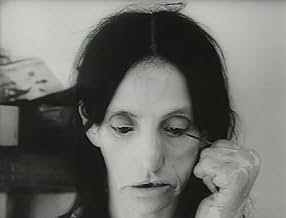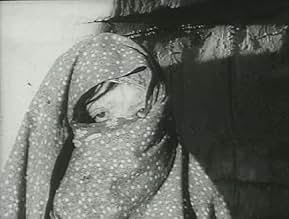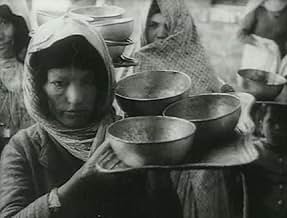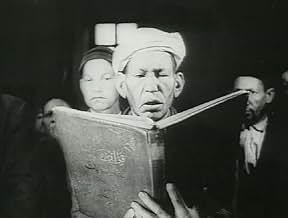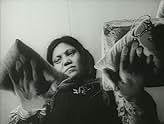IMDb-BEWERTUNG
7,8/10
6001
IHRE BEWERTUNG
Füge eine Handlung in deiner Sprache hinzuSet in a leper colony in the north of Iran, The House is Black juxtaposes "ugliness", of which there is much in the world as stated in the opening scenes, with religion and gratitude.Set in a leper colony in the north of Iran, The House is Black juxtaposes "ugliness", of which there is much in the world as stated in the opening scenes, with religion and gratitude.Set in a leper colony in the north of Iran, The House is Black juxtaposes "ugliness", of which there is much in the world as stated in the opening scenes, with religion and gratitude.
- Regie
- Drehbuch
- Hauptbesetzung
Forugh Farrokhzad
- Narrator
- (Nicht genannt)
Ebrahim Golestan
- Narrator
- (Nicht genannt)
Hossein Mansouri
- Self
- (Nicht genannt)
Empfohlene Bewertungen
This short makes my top 30 favorite films of all time. I didn't expect to love it as much as I did when I first saw it considering how poor the quality of the film is (in fact, there are a couple points where I can't make out the subtitles in the film due to how they blend in with the background). Given this, what did it do to impress me so much?
The line "Leprosy is not incurable" is repeated twice throughout an opening sequence which states facts about leprosy, almost as if to make sure the meaning of that line isn't lost concerning the grisly images we see of the people with the disease. Considering how the narrator points out how other people with the disease were cured when treated for it, this monologue also indicates that all the people we see suffering in the film could be cured of this disease. It's just that the government failed to take care of them as, instead of solving the problem, they herded them into the colony documented in the short, leaving them to further deteriorate. Instead of this scene coming off as preachy, this unspoken message is implied rather than directly stated, making for a really powerful scene. Regardless of whether you pick up on this implication or not, it still manages to get under your skin.
Farrokhzad also does a great job at exploring the ironies of the daily lives of the people in the colony, specifically with religion. Multiple sequences indicate that religion is a major part of their cultures. In one scene, a group of kids thank God for giving them hands, eyes, and ears - features which many people in the colony don't have. In another powerful moment, a man holds his withered hands in the air and refers to hands while reciting a prayer. This is followed by a sequence which cuts between a group of people practicing religion and several shots of people with deformed body parts which were brought about due to the disease, in turn creating tension with this editing technique. The viewer can't help but wonder why all these people thank God for giving them gifts which many of them don't have. It seems likely that religion is an abstract concept in their lives and they don't think much about the words and prayers they say.
In addition, a few sequences in the film stick out to me as especially powerful. The first of which shows a couple women putting on makeup and brushing their hair. This scene shows how, in spite of their facial and bodily features, many of the people in the colony still make an effort to look "beautiful", as if their goals are to connect with their past lives or to find light in such a depressing environment. Another scene shows a group of boys playing ball together. Unlike a number of the older people we see in the colony, their mobility doesn't seem to be effected by their disease. Despite this though, the grotesque facial features of a number of them are hard to ignore and, considering how the shot which immediately follows this sequence shows a man with one leg slowly walk down a path with the help of crutches, the short seems to suggest that those boys will grow up with further suffering and that they won't be able to experience moments like this unless they're cured of their disease (one effective shot which occurs earlier in the film shows a man giving his crutch to a boy to play with). One final scene worth mentioning is the classroom scene at the end. Something about this scene, specifically some of the answers the boys give to their teacher, makes it feel staged. It just seems too suited for the messages Farrokhzad wants to send to have naturally occurred. While I usually find staged scenes like this to be jarring in documentaries, I didn't mind it so much in here as it's still able to make for a devastating critique of religion.
Overall, this is a perfect short. Instead of solely raising awareness for the issue documented in it, Farrokhzad has several artistic points which she incorporates into the dialogue and the visuals of the film quite flawlessly as many of them are subtle or implied rather than directly stated. Sadly, Farrokhzad died shortly after this film was released, making this the only film she directed. Who knows what else she could've given us? However, this film will forever stand as a masterpiece to me and, if you can get by the occasional issues with the subtitles, you're in for a great treat with this one.
The line "Leprosy is not incurable" is repeated twice throughout an opening sequence which states facts about leprosy, almost as if to make sure the meaning of that line isn't lost concerning the grisly images we see of the people with the disease. Considering how the narrator points out how other people with the disease were cured when treated for it, this monologue also indicates that all the people we see suffering in the film could be cured of this disease. It's just that the government failed to take care of them as, instead of solving the problem, they herded them into the colony documented in the short, leaving them to further deteriorate. Instead of this scene coming off as preachy, this unspoken message is implied rather than directly stated, making for a really powerful scene. Regardless of whether you pick up on this implication or not, it still manages to get under your skin.
Farrokhzad also does a great job at exploring the ironies of the daily lives of the people in the colony, specifically with religion. Multiple sequences indicate that religion is a major part of their cultures. In one scene, a group of kids thank God for giving them hands, eyes, and ears - features which many people in the colony don't have. In another powerful moment, a man holds his withered hands in the air and refers to hands while reciting a prayer. This is followed by a sequence which cuts between a group of people practicing religion and several shots of people with deformed body parts which were brought about due to the disease, in turn creating tension with this editing technique. The viewer can't help but wonder why all these people thank God for giving them gifts which many of them don't have. It seems likely that religion is an abstract concept in their lives and they don't think much about the words and prayers they say.
In addition, a few sequences in the film stick out to me as especially powerful. The first of which shows a couple women putting on makeup and brushing their hair. This scene shows how, in spite of their facial and bodily features, many of the people in the colony still make an effort to look "beautiful", as if their goals are to connect with their past lives or to find light in such a depressing environment. Another scene shows a group of boys playing ball together. Unlike a number of the older people we see in the colony, their mobility doesn't seem to be effected by their disease. Despite this though, the grotesque facial features of a number of them are hard to ignore and, considering how the shot which immediately follows this sequence shows a man with one leg slowly walk down a path with the help of crutches, the short seems to suggest that those boys will grow up with further suffering and that they won't be able to experience moments like this unless they're cured of their disease (one effective shot which occurs earlier in the film shows a man giving his crutch to a boy to play with). One final scene worth mentioning is the classroom scene at the end. Something about this scene, specifically some of the answers the boys give to their teacher, makes it feel staged. It just seems too suited for the messages Farrokhzad wants to send to have naturally occurred. While I usually find staged scenes like this to be jarring in documentaries, I didn't mind it so much in here as it's still able to make for a devastating critique of religion.
Overall, this is a perfect short. Instead of solely raising awareness for the issue documented in it, Farrokhzad has several artistic points which she incorporates into the dialogue and the visuals of the film quite flawlessly as many of them are subtle or implied rather than directly stated. Sadly, Farrokhzad died shortly after this film was released, making this the only film she directed. Who knows what else she could've given us? However, this film will forever stand as a masterpiece to me and, if you can get by the occasional issues with the subtitles, you're in for a great treat with this one.
I hope my son's upcoming college class on Iranian film will be enlightening and enjoyable. In preparation for that, his instructor asked him to watch this short from Forugh Farrokhzad.
I had heard her name before but thought she was exclusively a writer (and one I have not yet read, alas).
Seeing this film....and reading a little more about her, was illuminating. And added to the spell that Iranian art has cast upon me.
It starts with an image, a reflection in a mirror. A scarred face, covered both by hijab and leprosy - with one eye searching. Who is watching who?
Actually, that is a lie. It starts with words. As befits a poet.
The film is available online, and I would almost recommend just reading the subtitles once through (or if they are excerpted somewhere, read them there before watching). Granted, I can only take in English, my tongue far from mastering Farsi. So hearing the words, Farrokhzad's long-gone but still-not-silent voice are part of the experience. Soft repetitions, almost mantras or prayers. Much questioning.
Is this the film that launched Kiarostami, Farhadi and others? There is an unflinching look at society. There is a tendency towards a more poetic than precise description. Thought above plot. Images too that may contrast the official story, of the film....or of the censors.
Images linger too - aspects of beauty, the combing of hair, and a camera pan to reveal. The applying of kohl with ravaged hands to a ravaged face. Still there is pride, there is beauty. The camera jumps into the middle of a volleyball game. We are there with them. We are them.
I do think that is the simple story here, Davids Bowie and Lynch gave us "Elephant Man." Farrokhzad moves through similar stark shadows. Honestly there is more light here. In a documentary. That dancing/singing/humming man. The laughter in the class room. Food, music, learning, work, love - these define us all as humans.
Anyways, I look forward to watching the movies in parallel with my son and his classmates. I've previously seen about half of them, which I will enjoy revisiting, like meeting up with a dear forgotten friend. But new introductions like these, I too will cherish.
Reading up on Farrokhzad, it is hard not to think of the film at least partially as a pariah dismissing those who dismiss her. There is a cure for leprosy, the film plainly repeats, though it is not a soft prayer, it is a hard fact. That said there is a biological cure, but perhaps not a societal one.
Like the great Iranian films that followed this one, there may be something that is not said and said at the same time.
There is so much beneath the surface. Of cinema, of society, of skin.
I had heard her name before but thought she was exclusively a writer (and one I have not yet read, alas).
Seeing this film....and reading a little more about her, was illuminating. And added to the spell that Iranian art has cast upon me.
It starts with an image, a reflection in a mirror. A scarred face, covered both by hijab and leprosy - with one eye searching. Who is watching who?
Actually, that is a lie. It starts with words. As befits a poet.
The film is available online, and I would almost recommend just reading the subtitles once through (or if they are excerpted somewhere, read them there before watching). Granted, I can only take in English, my tongue far from mastering Farsi. So hearing the words, Farrokhzad's long-gone but still-not-silent voice are part of the experience. Soft repetitions, almost mantras or prayers. Much questioning.
Is this the film that launched Kiarostami, Farhadi and others? There is an unflinching look at society. There is a tendency towards a more poetic than precise description. Thought above plot. Images too that may contrast the official story, of the film....or of the censors.
Images linger too - aspects of beauty, the combing of hair, and a camera pan to reveal. The applying of kohl with ravaged hands to a ravaged face. Still there is pride, there is beauty. The camera jumps into the middle of a volleyball game. We are there with them. We are them.
I do think that is the simple story here, Davids Bowie and Lynch gave us "Elephant Man." Farrokhzad moves through similar stark shadows. Honestly there is more light here. In a documentary. That dancing/singing/humming man. The laughter in the class room. Food, music, learning, work, love - these define us all as humans.
Anyways, I look forward to watching the movies in parallel with my son and his classmates. I've previously seen about half of them, which I will enjoy revisiting, like meeting up with a dear forgotten friend. But new introductions like these, I too will cherish.
Reading up on Farrokhzad, it is hard not to think of the film at least partially as a pariah dismissing those who dismiss her. There is a cure for leprosy, the film plainly repeats, though it is not a soft prayer, it is a hard fact. That said there is a biological cure, but perhaps not a societal one.
Like the great Iranian films that followed this one, there may be something that is not said and said at the same time.
There is so much beneath the surface. Of cinema, of society, of skin.
`There is no shortage of ugliness in the world.' the opening voice-over states as we see a horribly disfigured woman staring into a mirror. And by the film's end, we truly get an understanding of what she means.
`Khaneh siah ast' (The House is Black), written, directed and edited in 1963 by Forugh Farrokhzad is a brilliant piece of work done on an issue that has hardly been portrayed in any kind of film, fiction or non. Filmed in B&W on location somewhere on a Middle Eastern island, the film portrays a rapid series of events during the everyday lives of all of its inhabitants that are suffering from various stages of leprosy.
Cinematographer Soleiman Minasian uses mainly natural light and captures the pure essence of what living with leprosy is actually like. It is very startling. All the more startling due to Farrokhzad's rapid editing and cutting and disorienting flash-pans. And although the film is a documentary, there are certain scenes, which are entirely fabricated and contrived. One scene in particular is an actual tracking shot through a classroom where there is a coherent edited sequence of dialogue spoken between a teacher and his student. And although no one in the film is an actor, the scene was indeed scripted.
The reason the film is so brilliant is because Farrokhzad juxtaposes the images with extremely religious voice-over narration. Each individual that has leprosy prays to God and gives thanks for being alive in this world. It is harshly ironic that all living lepers are giving thanks and praise to a God that forces them to live through painful physical suffering everyday of their life.
They say leprosy is a curable disease, however, the impact and feeling you get from experiencing this film, is not.
`Khaneh siah ast' (The House is Black), written, directed and edited in 1963 by Forugh Farrokhzad is a brilliant piece of work done on an issue that has hardly been portrayed in any kind of film, fiction or non. Filmed in B&W on location somewhere on a Middle Eastern island, the film portrays a rapid series of events during the everyday lives of all of its inhabitants that are suffering from various stages of leprosy.
Cinematographer Soleiman Minasian uses mainly natural light and captures the pure essence of what living with leprosy is actually like. It is very startling. All the more startling due to Farrokhzad's rapid editing and cutting and disorienting flash-pans. And although the film is a documentary, there are certain scenes, which are entirely fabricated and contrived. One scene in particular is an actual tracking shot through a classroom where there is a coherent edited sequence of dialogue spoken between a teacher and his student. And although no one in the film is an actor, the scene was indeed scripted.
The reason the film is so brilliant is because Farrokhzad juxtaposes the images with extremely religious voice-over narration. Each individual that has leprosy prays to God and gives thanks for being alive in this world. It is harshly ironic that all living lepers are giving thanks and praise to a God that forces them to live through painful physical suffering everyday of their life.
They say leprosy is a curable disease, however, the impact and feeling you get from experiencing this film, is not.
It was the only movie made by Forough Farrokhzad.
A documentary of 20 minutes length; actually it is a documentary only at the first level of meaning: the disturbing images from a leper colony are meditated in verses that partner what's flowing on the screen. Fragments from Psalms, from Koran, from her own poetry. And her stanzas, sometimes in sync with the images, some times in counterpoint, always challenging the versets from the sacred books. One of the greatest poets of the twentieth century, that's what I believe Forough Farrokhzad is.
This movie is a cinematic poem: empathy for the extreme suffering, desolation that we cannot escape from our condition, and, in the same time, awe in face of the beauty of creation.
I think the key of the movie is done by two verses:
Who is this in hell Praising you, O Lord?
The hell is also part of the world; and it is ultimately beautiful because world is beautiful.
This is extraordinary here in the movie: the subtle impulse to see the Universe as beautiful in all its dimensions, even in its ugliest expressions - to see the splendor of the human condition, even in its most horrible shape.
Or maybe the verses tell us something slightly different: as they are in turn fearful, desolate, bitter, pessimistic, sarcastic against God and praising God, it is here the honesty and the courage of the poet to recognize having all these contradictory feelings. And this speaks indeed about the splendor of the human condition: to encompass everything, to assume all contradictions, to be their sovereign - as the Universe is.
A documentary of 20 minutes length; actually it is a documentary only at the first level of meaning: the disturbing images from a leper colony are meditated in verses that partner what's flowing on the screen. Fragments from Psalms, from Koran, from her own poetry. And her stanzas, sometimes in sync with the images, some times in counterpoint, always challenging the versets from the sacred books. One of the greatest poets of the twentieth century, that's what I believe Forough Farrokhzad is.
This movie is a cinematic poem: empathy for the extreme suffering, desolation that we cannot escape from our condition, and, in the same time, awe in face of the beauty of creation.
I think the key of the movie is done by two verses:
Who is this in hell Praising you, O Lord?
The hell is also part of the world; and it is ultimately beautiful because world is beautiful.
This is extraordinary here in the movie: the subtle impulse to see the Universe as beautiful in all its dimensions, even in its ugliest expressions - to see the splendor of the human condition, even in its most horrible shape.
Or maybe the verses tell us something slightly different: as they are in turn fearful, desolate, bitter, pessimistic, sarcastic against God and praising God, it is here the honesty and the courage of the poet to recognize having all these contradictory feelings. And this speaks indeed about the splendor of the human condition: to encompass everything, to assume all contradictions, to be their sovereign - as the Universe is.
Masterpiece is the basis of a documentary of its time to this day.
Therefore, Iran's documentary career honor the backing of this work.
Although successful movies have been seen in the Iranian documentary cinema from the first to present day, the collaboration of Ebrahim Golestan and Dear Forough Farrokhzad with documentary subjects has largely distinguished this film.
The documentary refers to a place where lepers people are taken from quarantined villagers.
The colony of lepers living together in an enclosed environment.
The most important thing in the audience's beliefs, as the name suggests, is the mere darkness of the world of leprosy, but with a particular look it can be concluded that the general documented theme is life expectancy.
This look can be viewed from a more in-depth angle at the wedding, kids' play and classroom. Because they laugh, despite physical problems, they play and even get married.
In any case, we can not rule out that the glass of water, in addition to half empty, has full half.
Forough Farrokhzad have lived for about ten days in order to accompany and coordinate of filming, and this represents a great spirit and professional approach.
Signs indicate that the documentary has the 19th place among the fifty documentary titles in the world, in the site and sond, which is typically a special art work for Iran.
Wusstest du schon
- WissenswertesIt was the only film Farrokhzad directed before her death in 1967. During shooting, she became attached to a child of two lepers, whom she later adopted.
- VerbindungenFeatured in Cinema Iran (2005)
Top-Auswahl
Melde dich zum Bewerten an und greife auf die Watchlist für personalisierte Empfehlungen zu.
Details
- Laufzeit
- 20 Min.
- Farbe
- Sound-Mix
- Seitenverhältnis
- 1.37 : 1
Zu dieser Seite beitragen
Bearbeitung vorschlagen oder fehlenden Inhalt hinzufügen

